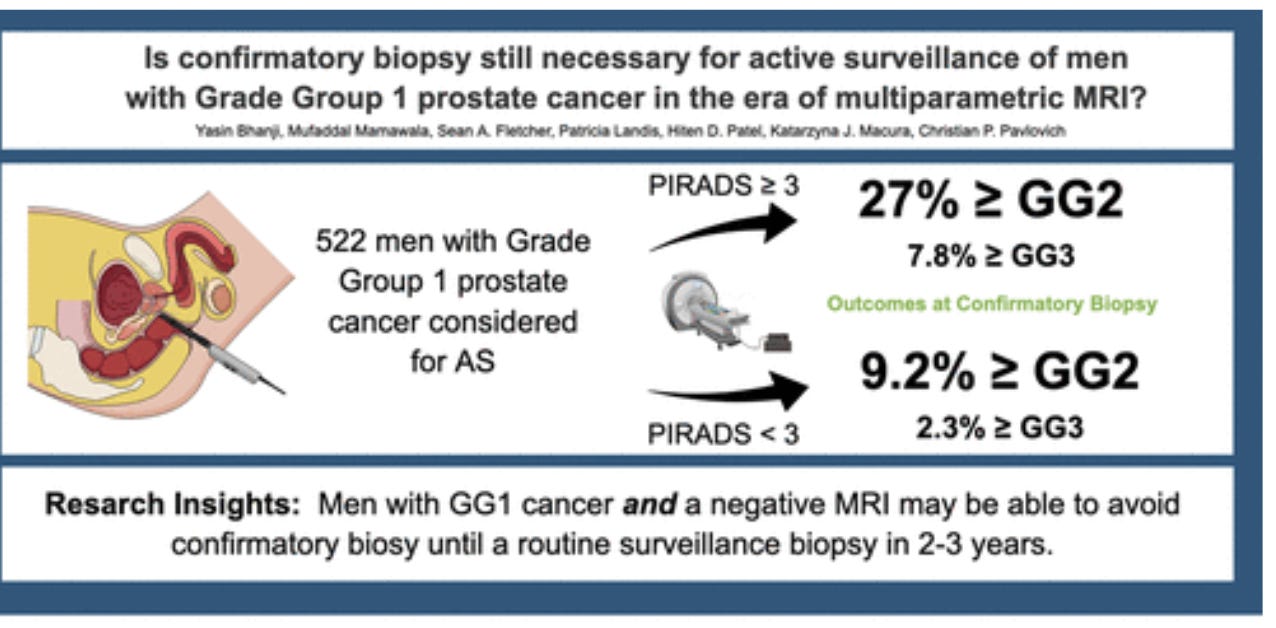On-again, off-again lesions on MRI scan? Dr. Westphalen responds.
Black men and Latinos sought for NYU study on prostate cancer.
(Editor’s note. After a brief absence, our star abdominal radiology expert is back responding to questions. If you have questions about low-risk prostate cancer, your pathology report, your abdominal MRI scan, and diet/lifestyle, please send them to me at howard.wolinsky@gmail.com. If you’re a paid subscriber, I’ll have news soon about plans for the Active Surveillance 2026 webinar.—HW.)
A patient asks: Had an MRI about a year ago. The radiologist said I had a single PIRADS-3 lesion. Had biopsy and only one core had 5% Gleason 6 out of 14 cores. Fast forward a year had follow-up MRI. Now the report says previous lesion was gone and now new lesion PIRADS-3.
Are these things that fluid?
Confused in Cincinnati
Dr. Antonio Westphalen answers, It’s hard to know exactly what happened in your specific case without reviewing the images from both MRI exams. That said, I can share some general information that may help you make sense of the findings.
• About 5–15% of PI-RADS 3 lesions turn out to be high-grade prostate cancer (Gleason 3+4 or higher). If we include Gleason 3+3 cancers, the percentage is higher.
• PI-RADS 3 lesions are quite common on prostate MRI. These are findings that are not clearly suspicious but not completely benign either.
• In the peripheral zone (PZ), these subtle findings may represent transient inflammation or scarring, for example. In the transition zone (TZ), mildly atypical BPH nodules can also classified as PI-RADS 3.
• It’s possible that the lesion seen on the first MRI truly resolved or became less conspicuous by the time of your follow-up.
• It’s also possible that the second radiologist saw the same area but didn’t consider it suspicious anymore and therefore didn’t report it.
• Despite being a standardized scoring system, MRI interpretation is still largely subjective. Some differences between reports are expected, especially when the findings are subtle or nonspecific.
• When prior images are available, radiologists usually try to address any discrepancies and explain whether a finding has resolved, changed, or why it was interpreted differently. If that wasn’t done, it’s usually okay to ask for a direct comparison. And if the prior images weren’t available at the time of interpretation, you can provide them so that a comparison can be made.
Dr. Westphalen is the Section Chief of abdominal imaging at the University of Washington and UW professor of radiology. Dr. Westphalen’s research interests are centered on the use of advanced imaging technologies to diagnose and treat patients with prostate cancer.
New study at NYU Langone Health seeking Black or Hispanic patients with prostate cancer
There has been a shortage of research on Black and Latino patients with prostate cancer.
Dr. Stacy Loeb, a prostate cancer and men’s health expert at NewYork University Langone Medical Center, needs the help of Black and Latino patients in a study about how these men use online informatiopn about prostate cancer,
Why is this study being done?
• To examine the perspective of Black and Hispanic patients with prostate cancer and at-risk for prostate cancer about online information. The ultimate goal is to help improve outcomes for Black and Hispanic males with prostate cancer.
Who may take part in this study?
• Black or Hispanic U.S. adult male,
• Age 40 or older OR diagnosed with prostate cancer.
• Have internet access with audio/video capabilities (if planning to participate virtually).
What will participation in this study involve?
• Completing a questionnaire online.
• Taking part in a focus group discussion lasting about 60-90 minutes.
• Option to participate virtually via WebEx/Zoom or in-person at NYU Langone Health.
• A $50 electronic Amazon gift card for study participation
Participation is voluntary. For more information, please contact:
• Nataliya Byrne: Nataliya.Byrne@nyulangone.org • 646-501-2681
• Tatiana Sanchez Nolasco: Tatiana.Sancheznolasco@nyulangone.org • 646-501-2550
• Mariana Rangel: Mariana.RangelCamacho@nyulangone.org • 646-501-2552
• Evangelia Pitsoulakis: Evangelia.Pitsoulakis@nyulangone.org
To confirm this study is valid:
• Contact the NYU Langone Health Institutional Review Board (IRB) at 212-263-4110
• Reference the study number (23-00135)
Here’s a link to some previous research Loeb did on the lack of Black and brown faces in internet content relating to prostate cancer: https://www.medscape.com/viewarticle/968371
What else is new in Low-risk PCa-land?
—Confirmatory testing. Can you tell The Active Surveillor about your experience with confirmatory testing for PCa? The poll is here: https://docs.google.com/forms/d/1jVJJodEUdd5x6nRTAArDUI2VMsdW6GlkAAxcdEGfplE/edit#responses
Check out the story on the studies on confirmatory testing:
—Last chance. Please take a minute to respond to this survey on your experience with transperineal vs. transrectal biopsies: https://forms.gle/FjC4o6hWj2BZYhKN6
—Watch the videos the new The Active Surveillor’s YouTube channel. I have started posting some interviews I do to research articles in the newsletter. Why not join in? https://www.youtube.com/@TheActiveSurveillor Watch for exclusive interviews.
—Weigh in on your experience with confirmatory testing in this poll: https://forms.gle/2RjQxXyHCYGTo4wJ9 See latest research on confirmatory testing:
—Gotta’ have heart. Don’t miss the ASPI webinar on trying to fend off the greatest health threat we AS patients and most other prostate cancer patients face. It’s not prostate cancer. It’s heart disease. Dr. Darryl Leong, of McMaster U. (Go Marauders!), is a rare cardiologist who studies prostate cancer.
He is the featured speaker at Active Surveillance Patients International webinar from noon-1:30 p.m. Eastern on Saturday April 26. Register here: [https://zoom.us/meeting/register/xgT8w-i3Qp-iJkvOby0M9g]
—You’ve got guts. Researchers at University of California, San Diego are validating the gut microbiome—the community of germs in our gut that help keep us going— as a biomarker for prostate cancer aimed at men on Active Surveillance for low-risk prostate cancer. Participants get a free diet assessment/score, a microbiome report, and $25 gift card. See if you’re eligible:https://oncobiomix.studyenrollment.com
—What to do about indolent prostate cancer? The Genitourinary Pathology Society (GUPS) and the International Society of Urological Pathology (ISUP) are calling for a multidisciplinary team approach with urologists, radiologists, radiation oncologists, and pathologists to determine how best to manage cases of indolent/”lazy” PCa, per my report in Medscape. “Reliable identification of indolent prostate cancer at needle biopsies is not possible,” the societies stated. “This is because sampling errors, disease progression, or the different molecular makeup may contribute to such discrepancies.” The societies define indolent PC as “low-volume, well-differentiated acinar neoplasm with invasive histologic features that do not spread outside the prostate, become symptomatic, or shorten a patient’s life if left untreated.” The white paper appeared last month in European Urology.
Unsolicited testimonial
John Baringer: Howard, the information you provide is incredibly valuable and useful! I have been on my AS journey for almost 7 years and would have probably surrendered to radical treatment years ago had I not discovered you! I’m sure I speak for many others who found the courage and the calm to stay on the AS train because of the bright light you have shown on this topic!!!"
Thanks, John. I appreciate the support. Howard




OK, what does this mean? (Not a comment on Howie's newsletter, which was excellent as usual.)
"Don’t miss the ASPI webinar on trying to fend off the greatest health threat we AS patients and most other prostate cancer patients face. It’s not prostate cancer. It’s heart disease."
Why does having PCa have anything to do with HD? Is it just coincidence? Does T have anything to do with it? Lastly, have we finally determined the origin of the expression "All men will die with PCa, but not all men will die from it."?